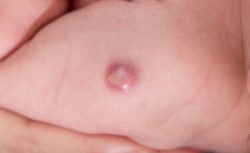
Incision and Drainage
In situations where a sore on the skin becomes infected and pus builds up under the skin, a visit to Dr. Ward may be necessary. These sores, generally known as skin abscesses, are painful, appear pink or red and is warm to the touch. Abscesses typically occur on the extremities and buttocks but may also occur anywhere on the body where there are hair follicles. Many abscesses originate in the hair follicles.
WHEN SHOULD I CALL FOR AN APPOINTMENT?
As an abscesses enlarges, it may “come to a head” and rupture on its own allowing the pus to drain and heal without medical attention. In other cases where the abscess worsens, becomes more painful and infection begins to spread, Dr. Ward should be contacted for an appointment.
Dr. Ward will likely need to exam the abscess and determine if an Incision and Drainage procedure is necessary to promote healing. Call for an appointment if:
- The abscess continues to expand beyond 1/2 inch in size.
- A fever persists or reaches above 100.4 degrees.
- The sore becomes more painful.
- The person has an underlying illness.
- The person is taking prescription drugs that suppress the immune system.
- The sore located near or on the rectal or groin area.
HOW IS THE PROCEDURE PERFORMED?
The purpose of the Incision and Drainage (I & D) procedure is to remove the pressure and drain the infection giving the sore a chance to heal. The minor surgical procedure is performed by cleaning the area with an antiseptic and then making a small incision to puncture the skin.

The incision is made using a sterile instrument like a sharp needle or a scalpel. Once the incision is made, the pus fluid drains out through the incision. If necessary, stitches may be used to close the incision.
Once the pus has drained and the incision has been stitched (if necessary), the sore is covered with a thin layer of gauze.
AFTER CARE INSTRUCTIONS
Once the procedure has been performed, follow any specific directions from Dr. Ward or his staff. The general after-care Instructions include:
- Take any pain or antibiotic medicine that may have been prescribed, as directed.
- Keep the bandage clean and dry.
- Elevate the wound as much as possible if the wound is on the arm or leg — Raise above the level of the heart.
- Remove and clean the wound as directed.
- As directed, begin to soak the wound in warm water 20 minutes a day for a week.
Call Dr. Ward if the following are experienced:
- Fever or chills.
- Excessive Fatigue.
- Return of the abscess.
- The area around the abscess has red streaks.
- The area around the abscess is warm and painful.
- Persistent bleeding.
Call Dr. Ward for an appointment if you are experiencing symptoms of an abscess and may need medical assistance.
